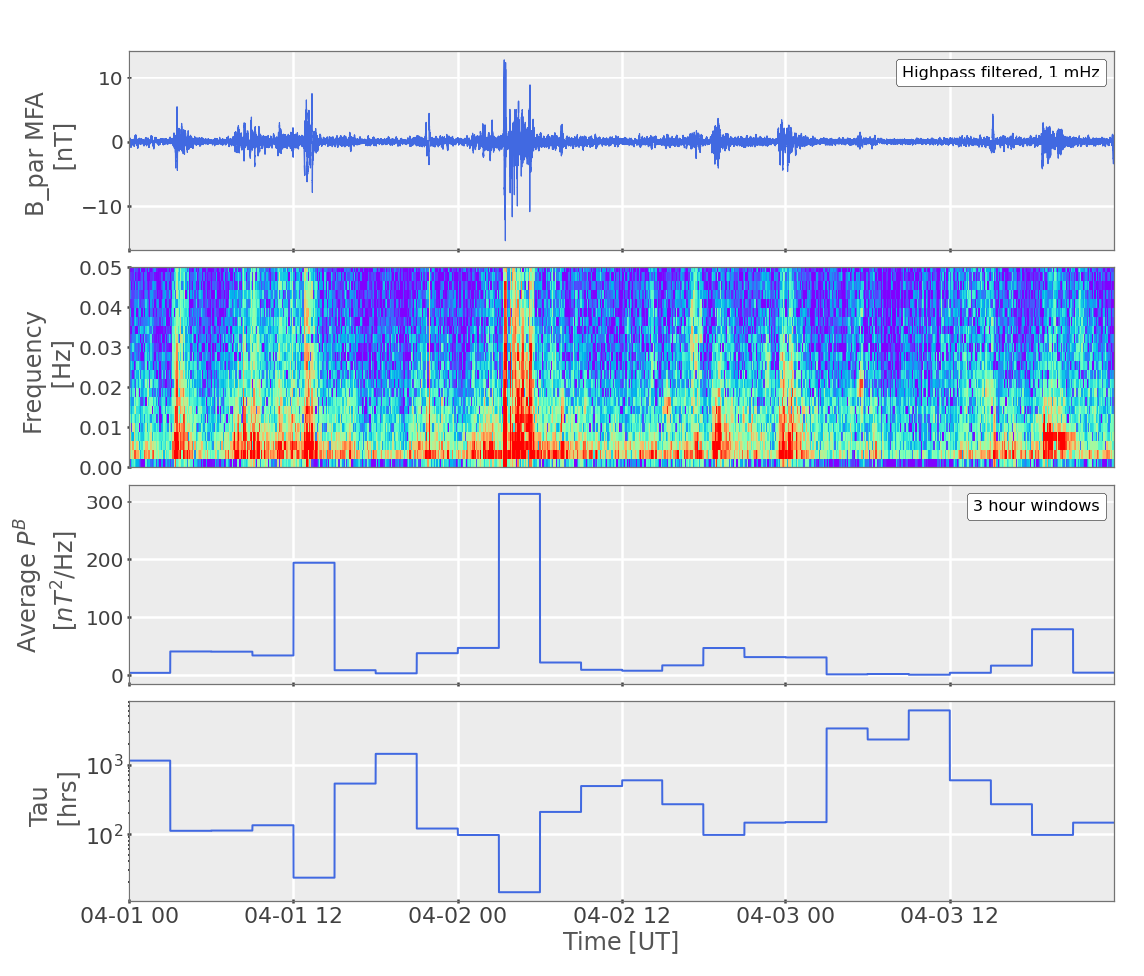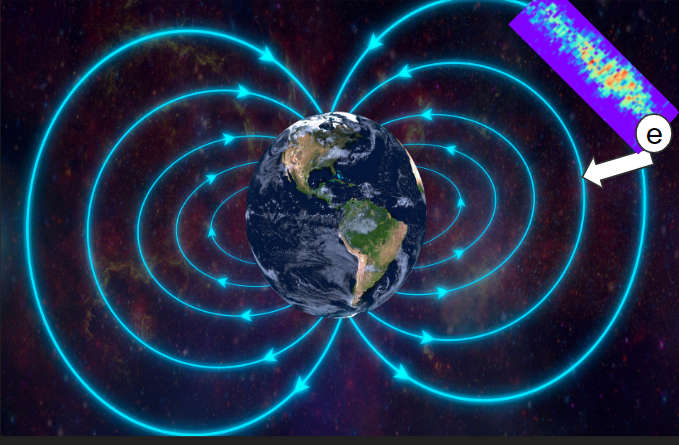This repo was created by students in the Fall 2023 semester of Software Engineering for Scientists (SWE4S) course at University of Colorado, Boulder with the intent of helping answer this question in future studies.
The figure below shows the important calculations and outputs.
- The first panel is a timeseries of the parallel component of the magnetic field filtered for the frequency band of interest. This shows when increases in amplitude occur.
- The second panel is a spectrogram which has time on the x axis, frequency on the y and the color is the power (blue is low, red is high). The red bursts of high power in the lower frequencies are the plasma waves we are interested in. You can also see the bursts correspond with amplitude increase in the above panel.
- The third panel is the average power spectral density (PSD) in the frequency band over time. This calculation is done in 3 hour intervals, hence why it is a line plot with steps. You can see that when the amplitude and power in the above plots increase, the average PSD also increases.
- The final panel is tau, or the electron radial diffusion time scale. Again, this correlated nicely as times with higher power have shorter timescales (more power -> diffuse electrons quicker).

- Calculate observed wave properties and how long it would take an electron to diffuse one Earth radius towards Earth due to wave-particle interactions (also known as diffusion time)
- Use these parameters to better inform radiation belt models that currently rely on proxy indices
- Data Analysis : ULFW uses GOES L2 high-res magnetic field data to perform analysis of Ultra-Low-Frequency (ULF) waves in space.
- Diffusion Time Calculation : Calculate the time it takes for an electron to diffuse one Earth radii towards Earth due to wave-particle interaction.
- Data Visualization : Generate time series plots
- User-Friendly : This project was designed to be user-friendly and with best code practices.
- Clone this repo and ensure all environment requirements are fulfilled
- Run
main.pywhich is located in thesrcfolder -- expected run time for full day: 1-2 minutes.
Mutable user inputs are:
filename(.nc data file path and name -- required)timespan(time per window in hours, must go evenly into 24 -- default is 1)num_entries(number of entries in data file -- default is 864000)fband(frequency band in Hz -- default is [0.001, 0.01])comp(component of the magnetic field to filter; 0=radial, 1=phi, 2=parallel -- default is 2)ftype(frequency type; options are 'highpass', 'lowpass', or 'bandpass' -- default is 'highpass')
From the src directory, run (adding any optional inputs as desired)
python main.py --filename foo.ncHere's an example of a run which specifies all possible inputs:
python main.py --filename foo.nc --timespan 1 --num_entries 864000 --fband 0.001 0.01 --comp 2 --ftype 'highpass'Visit https://www.ngdc.noaa.gov/stp/satellite/goes-r.html This code repo works best with the NCEI L2 data. Click on the GOES-*-L2 button for the satellite you are interested in. Then choose magn-l2-hires -> year -> day. All file names adhere to the following structure: dn-magn-l2-hires_g<16,17 or 18>_d_v1-0-1.nc
The data files are netCDF4 files. This is a self-describing dataset which contains 10Hz magnetometer measurements. The level 2 data has been calibrated, converted to scientific units and converted to scientific coordinate frames. For more information about working with netCDF4 datafiles, visit https://unidata.github.io/netcdf4-python/
To run individual unit tests, first navigate to the unit test directory.
cd test/unit
python -m unittest test_plots.py
To run functional tests, navigate to the functional test directory.
cd test/functional
bash func_tests.sh
Note: functional tests use this test file for ensuring functionality.
Running main.py as specified above, will create and save the following output files in in the docs folder:
-
output_plot_FILENAME.pngwhere FILENAME is the name of the input file (e.g. if the input file isfoo.nc, the output plot will be saved asoutput_plot_foo.png) -
tau_dict_FILENAME.pklwhere FILENAME is the name of the input file. The saved parameters in this file are the following:-
tau: Timescale to diffuse one L shell (Earth radius), given in minutes [int] -
D_LL: Diffusion coefficient [float] -
psd: Average power spectral density for the frequency band of interest, given in nT2/Hz [int]
-
Expand for version release updates
Final project release. Implemented code review comments. Made sure documentation was consistent. Fixed bugs in window output. Finalized plotting capabilities. Added save capabilities for plot outputs and dictionary outputs.
First full draft before the code review. Split one file that runs everything into different modules, created initial unit and functional tests, a main file to call all the functions, and a run.sh file.
MIT License
Copyright (c) 2023 sauriemma11
Permission is hereby granted, free of charge, to any person obtaining a copy of this software and associated documentation files (the "Software"), to deal in the Software without restriction, including without limitation the rights to use, copy, modify, merge, publish, distribute, sublicense, and/or sell copies of the Software, and to permit persons to whom the Software is furnished to do so, subject to the following conditions:
The above copyright notice and this permission notice shall be included in all copies or substantial portions of the Software.
THE SOFTWARE IS PROVIDED "AS IS", WITHOUT WARRANTY OF ANY KIND, EXPRESS OR IMPLIED, INCLUDING BUT NOT LIMITED TO THE WARRANTIES OF MERCHANTABILITY, FITNESS FOR A PARTICULAR PURPOSE AND NONINFRINGEMENT. IN NO EVENT SHALL THE AUTHORS OR COPYRIGHT HOLDERS BE LIABLE FOR ANY CLAIM, DAMAGES OR OTHER LIABILITY, WHETHER IN AN ACTION OF CONTRACT, TORT OR OTHERWISE, ARISING FROM, OUT OF OR IN CONNECTION WITH THE SOFTWARE OR THE USE OR OTHER DEALINGS IN THE SOFTWARE.

